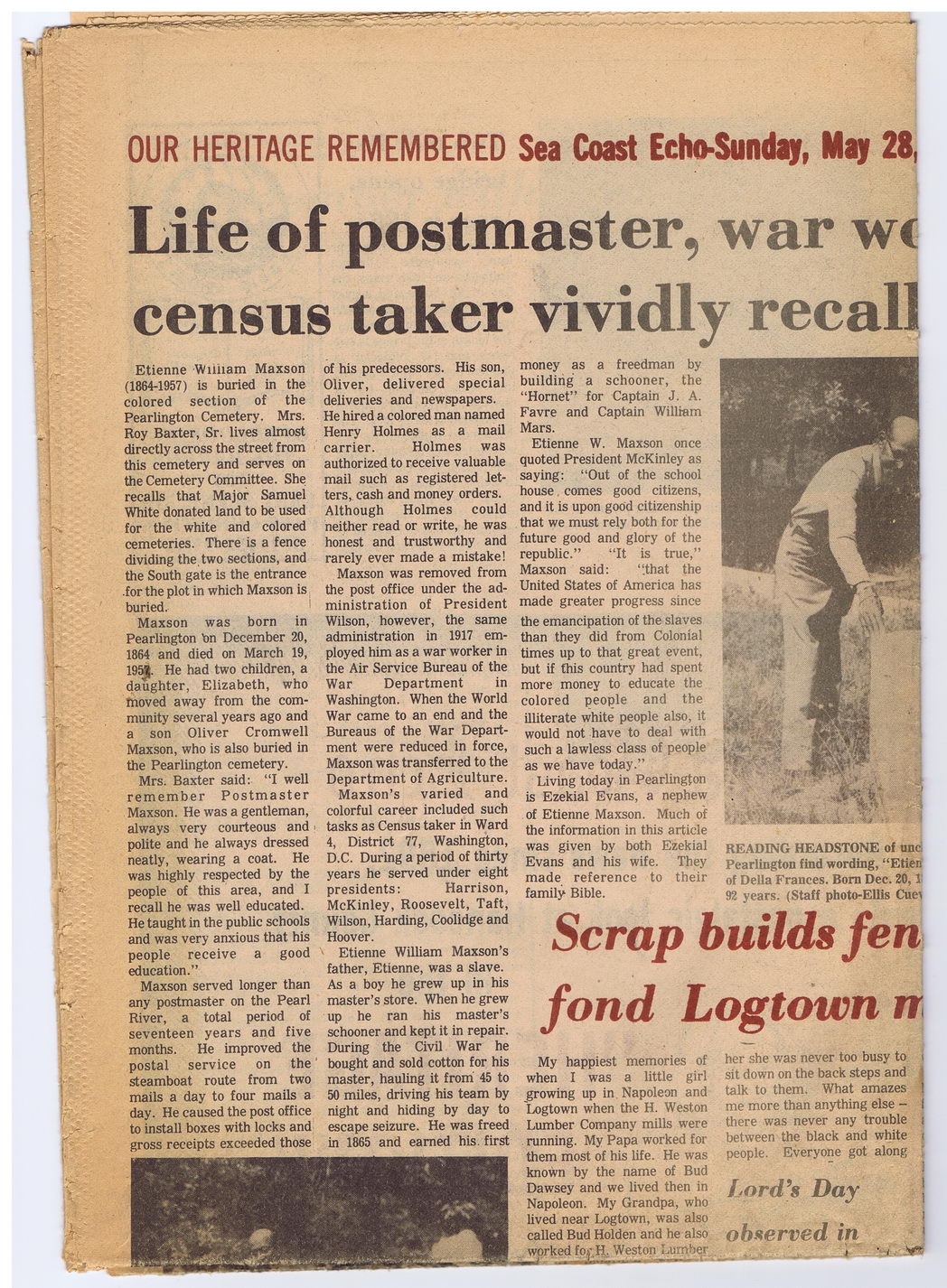This text was obtained via automated optical character recognition.
It has not been edited and may therefore contain several errors.
OUR HERITAGE REMEMBERED Sea Coast Echo-Sunday, May 28, Life of postmaster, war wc census taker vividly recall Etienne Wniiam Maxson (1864-1957) is buried in the colored section of the Pearlington Cemetery. Mrs. Roy Baxter, Sr. lives almost directly across the street from this cemetery and serves on the Cemetery Committee. She recalls that Major Samuel White donated land to be used for the white and colored cemeteries. There is a fence dividing the. two sections, and the South gate is the entrance for the plot in which Maxson is buried. Maxson was born in Pearlington Ion December 20, 1864 and died on March 19, 195?- He had two children, a daughter, Elizabeth, who moved away from the community several years ago and a son Oliver Cromwell Maxson, who is also buried in the Pearlington cemetery. Mrs. Baxter said: “I well remember Postmaster Maxson. He was a gentleman, always very courteous and > polite and he always dressed neatly, wearing a coat. He was highly respected by the people of this area, and I recall he was well educated. He taught in the public schools and was very anxious that his people receive a good education.” Maxson served longer than any postmaster on the Pearl River, a total period of seventeen years and five months. He improved the postal service on the ’ steamboat route from two mails a day to four mails a day. He caused the post office to install boxes with locks and gross receipts exceeded those of his predecessors. His son, Oliver, delivered special deliveries and newspapers. He hired a colored man named Henry Holmes as a mail carrier. Holmes was authorized to receive valuable mail such as registered letters, cash and money orders. Although Holmes could neither read or write, he was honest and trustworthy and rarely ever made a mistake! Maxson was removed from the post office under the administration of President Wilson, however, the same administration in 1917 employed him as a war worker in the Air Service Bureau of the War Department in Washington. When the World War came to an end and the Bureaus of the War Department were reduced in force, Maxson was transferred to the Department of Agriculture. Maxson’s varied and colorful career included such tasks as Census taker in Ward 4, District 77, Washington, D.C. During a period of thirty years he served under eight presidents: Harrison, McKinley, Roosevelt, Taft, Wilson, Harding, Coolidge and Hoover. Etienne William Maxson’s father, Etienne, was a slave. As a boy he grew up in his master’s store. When he grew up he ran his master’s schooner and kept it in repair. During the Civil War he bought and sold cotton for his master, hauling it from 45 to 50 miles, driving his team by night and hiding by day to escape seizure. He was freed in 1865 and earned his. first money as a freedman by building a schooner, the “Hornet” for Captain J. A. Favre and Captain William Mars. Etienne W. Maxson once quoted President McKinley as saying: “Out of the school house comes good citizens, and it is upon good citizenship that we must rely both for the future good and glory of the republic.” “It is true,” Maxson said: “.that the United States of America has made greater progress since the emancipation of the slaves than they did from Colonial times up to that great event, but if this country had spent more money to educate the colored people and the illiterate white people also, it would not have to deal with such a lawless class of people as we have today.” Living today in Pearlington is Ezekial Evans, a nephew of Etienne Maxson. Much of the information in this article was given by both Ezekial Evans and his wife. They made reference to their family Bible. READING HEADSTONE of unc! Pearlington find wording, “Etien of Della Frances. Born Dec. 20,1 92 years. (Staff photo-Ellis Cue> Scrap builds fen fond Logtown n My happiest memories of when I was a little girl growing up in Napoleon and Logtown when the H. Weston Lumber Company mills were . running. My Papa worked for them most of his life. He was known by the name of Bud Dawsey and we lived then in Napoleon. My Grandpa, who lived near Logtown, was also called Bud Holden and he also . worked fof.H. Weston Lumber her she was never too busy to i sit down on the back steps and talk to them. What amazes me more than anything else - I there was never any trouble j between the black and white i people. Everyone got along ; Lord’s Day-observed in i

Pearlington City Document (057)